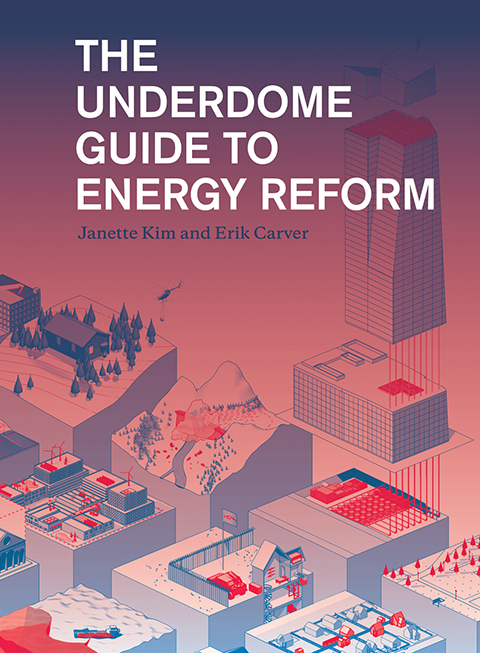by: ac
On 11.09.15, Janette Kim, Assistant Professor, Syracuse University, and Erik Carver, Teaching Fellow, Columbia University, presented their new book, The Underdome Guide to Energy Reform (Princeton Architectural Press, November 2015), at the Center for Architecture. The talk was moderated by Matt Shaw, Senior Editor, The Architect’s Newspaper.
In the well-crafted introduction to the book, the final sentence sets the tone for how one is to move through the text: “After all, in a climate crisis, shouldn’t every option be on the table?” While this premise is valid and expertly illustrated, it is nevertheless uncomfortable. The authors are not naive or particularly nihilistic, but merely setting up a very interesting method of analysis that succeeds in keeping “the uncomfortable” in the conversation. The book is organized around four agendas: Power, Territory, Lifestyle, and Risk, each introduced with essays by contributors such as Georgeen Theodore, AIA, of Interboro Partners, and architectural historians Reinhold Martin, Jonathan Massey, and Michael Osman. Almost hidden are transcripts of expert panel discussions from the Underdome Sessions at Columbia University’s Studio-X NYC. It is not quite clear how these conversations were orchestrated, but they usher in the key and balanced agendas of each particular section.
The authors put forth a massive metaphor to structure the entire book: Buckminster Fuller’s Dome over Manhattan. Fuller’s dome acts as a structural metaphor for this argument/non-argument. His idea of placing a dome over Manhattan struck some as dehumanizing, but the actual pragmatics and science of the scheme could potentially work, rendering it an idea to analyze and explore. In The Underdome, we are treated to about 150 pages of similarly provocative proposals via illustrations and an infographic manifesto.
A major function of this book is to assess the role or power of the infographic. The drawings are handsome and adeptly composed. But as with so much of the role of an infographic, the relationship of the very distilled image to the text puts forth a disturbing disconnect. In order to support the all-ideas-are-good-ideas premise, are we ready to digest the headings “Share” and “Communal Living” with an analysis of Angola State Prison as an exemplar? Picking okra and cotton is back-breaking work, especially in 95-degree heat with 90% humidity. This is where infographics break down – when the human element inconveniently intervenes.
Each “agenda” is illustrated and annotated by a manifesto-like dictum. The authors’ overuse of the word “should” at the beginning of every agenda is disconcerting. Not only does it set a monotonous tone, but it is an oddly judgmental in this forum of proposed non-judgmental solutions.
The authors’ most compelling argument, even amidst all this non-revolution/revolution, is the idea that re-structuring the family unit could be the key to negotiating the energy crisis. The intriguing notion that decoupling the family unit from the conversation about housing policy might ease expectations, and allow an “aesthetics of density” to come forward. Massey’s eloquent essay “Designing Consumption” outlines the development of Fuller’s thinking, beginning with the idea of domesticity. Fuller set up limited choices for lifestyle in order for these choices to bring forth more options. Massey maintains this is our dilemma. He sites the Romans’ mandated control over ownership and display of wealth in order to promote an ethos of republican virtue, and the Renaissance humanists’ treatment of consumerism as a vice and a threat to civic life. When are we as a culture really going to upend lifestyles in order to mediate energy consumption? Massey’s refreshingly tempered view saves the rest of the project from an odd radical intellectualism and gets the text back to an earnest questioning.
The Underdome is a tremendous achievement. The very idea of drawing policy or cultural temperament is really valid and noteworthy, a brand new filter for critical thinking. The book presents itself more as a project, perhaps ongoing, than a formal conclusion. But with a crisis so urgent, do we have time to assess even the dehumanizing proposals?
Event: Oculus Book Talk: The Underdome Guide to Energy Reform
Location: Center for Architecture, 11.09.15
Speakers: Janette Kim, Assistant Professor, Syracuse University; Erik Carver, Teaching Fellow, Columbia University; and Matt Shaw, Senior Editor, The Architect’s Newspaper
Organized by: AIANY Oculus Committee








